Craigieburn is the name of a settlement and several geographic features in northwest Canterbury, in New Zealand's South Island.

The Caelifera are a suborder of orthopteran insects. They include the grasshoppers and grasshopper-like insects, as well as other superfamilies classified with them: the ground-hoppers (Tetrigoidea) and pygmy mole crickets (Tridactyloidea). The latter should not be confused with the mole crickets (Gryllotalpidae), which belong to the other Orthopteran sub-order Ensifera.

Hemiandrus is a genus of wētā in the family Anostostomatidae. In New Zealand they are known as ground wētā due to their burrowing lifestyle. Hemiandrus wētā are nocturnal, and reside in these burrows during the day. Ground wētā seal the entrance of their burrow during the day with a soil plug or door so that their burrow is concealed. This genus was originally said to be distributed in Australia and New Zealand, however, with recent molecular genetic methods, this is under debate. Ground wētā adults are smaller than other types of wētā, with the unusual trait of having both long and short ovipositors, depending on the species. The name of this genus is said to come from this trait as hemi- mean half and -andrus means male, as the species where the female has a short ovipositor can sometimes be mistaken for a male. This genus has a diverse diet, depending on the species.

Sigaus homerensis is a grasshopper endemic to the southern South Island of New Zealand. It is known only from three isolated populations in Fiordland.

Sigaus childi is an endangered protected species of grasshopper known only from the Alexandra district of the South Island of New Zealand. It is one of just two species of grasshopper listed for protection under the New Zealand Wildlife Act 1953. It is currently classified as "At Risk, Naturally Uncommon" by the Department of Conservation. The genus Sigaus is endemic to New Zealand.

Brachaspis robustus is a nationally endangered species of grasshopper endemic to the Mackenzie Basin of the South Island of New Zealand. The genus Brachaspis is endemic to the South Island of New Zealand. Although a grasshopper, it is a poor jumper, relying on camouflage to hide from predators. It is threatened by introduced mammals such as stoats, hedgehogs, and rats.
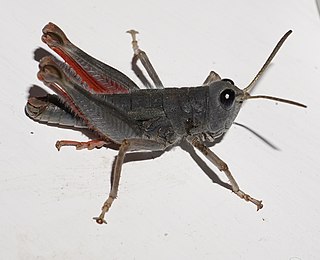
Sigaus villosus is New Zealand's largest grasshopper. It is only found in the central mountains of the South Island. The genus Sigaus is endemic to the New Zealand. Like all of New Zealand sub-alpine and alpine grasshoppers S. villosus has a 2 or 3 years life cycle. The eggs must ‘overwinter’ before they will hatch. Hoppers are found throughout the year and adult grasshoppers can be found throughout the New Zealand summer between December and April. Adult S. villosus do not overwinter.

Alpinacris tumidicauda is a species of grasshopper only known from Otago and Southland, New Zealand. The genus Alpinacris is endemic to the South Island of New Zealand. A. tumidicauda was described in 1967 by Robert Sidney Bigelow, with a type locality of Obelisk in the Old Man Range (45°19′22″S169°12′27″E). A male holotype and paratype are deposited in the Canterbury Museum, Christchurch. Like all of New Zealand sub-alpine and alpine grasshoppers, A. tumidicauda has a 2- or 3-year life cycle. The eggs must "overwinter" before they will hatch. Hoppers are found throughout the year, and adult grasshoppers can be found throughout the New Zealand summer between December and April. The adult A. tumidicauda do not overwinter.

Sigaus of grasshoppers in the tribe Catantopini that isendemic to New Zealand, and all but one species is endemic to the South Island: Sigaus piliferus is the only North Island representative and is the type species. There are eight species in the genus; all are flightless, and many are coloured for camouflage against rocky ground. Sigaus minutus and S. childi are threatened with extinction.

Sigaus australis is the most common alpine grasshopper found in New Zealand. It can be found in the southern half of the South Island above the tree line. Sigaus australis was described in 1897 by Frederick Hutton. Like all of New Zealand sub-alpine and alpine grasshoppers S. australis has a 2 or 3 years life cycle. Individuals can survive the cold by freezing solid at any life stage, at any time of the year. Sigaus australis adults are relatively large grasshoppers. The genus Sigaus is endemic to New Zealand.

Alpinacris crassicauda is a species of grasshopper only known from West Coast Region and Tasman Region, New Zealand. The genus Alpinacris is endemic to the South Island of New Zealand. A. crassicauda was described in 1967 by Robert Sidney Bigelow, with a type locality of Lead Hills, Boulder Lake. A male holotype and paratype are deposited in the Canterbury Museum, Christchurch. Like all of New Zealand sub-alpine and alpine grasshoppers A. crassicauda has a 2 or 3 years life cycle. The eggs must ‘overwinter’ before they will hatch. Hoppers are found throughout the year and adult grasshoppers can be found throughout the New Zealand summer between December and April. The adult A. crassicauda do not overwinter.

Phaulacridium marginale is a small species of short-horned grasshopper in the family Acrididae. It is endemic to New Zealand where it is found in low elevation open habitat throughout North Island, South Island, Stewart Island and on many smaller islands.

Phaulacridium is a genus of grasshoppers in the tribe Catantopini from Australia and New Zealand. These short-horned grasshoppers have a single generation each year
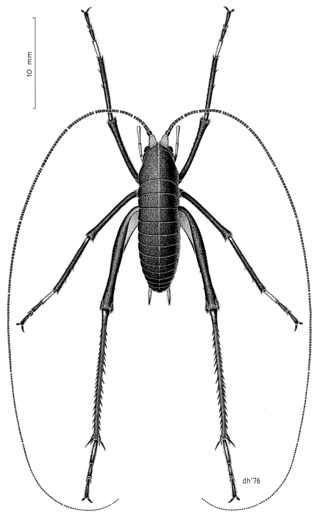
Pharmacus montanus, the Mount Cook flea, is a type of cave wētā found above the tree line in the South Island of New Zealand. It was first described by Francois Jules Pictet de la Rive and Henri Saussure in 1893. Pharmacus montanus is one of the most widespread species within the genus, found from Aoraki/Mount Cook to Mt Owen in northern South Island. The highest recorded specimens of this species are from a population between 2700 and 2800 m above sea level on Mt Annan above the Tasman Glacier.

Mary Morgan-Richards is a New Zealand biologist, and as of 2019 is a full professor at the Massey University.
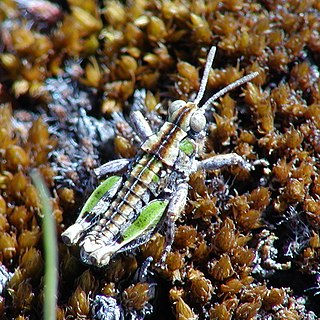
Sigaus minutus is a species of short-horned grasshopper in the family Acrididae. It is one of the smallest and rarest species of grasshopper in New Zealand, found only in the Mackenzie district of South Island. There are nine species within the genus Sigaus described by Bigelow (1967), all endemic to New Zealand. The population status of Sigaus minutus is declining according to threat assessments made by orthopteran experts in 2010.
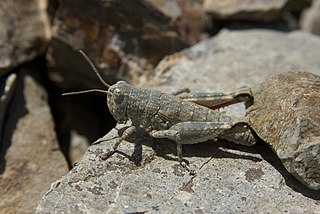
Brachaspis nivalis, is an alpine short-horned grasshopper, endemic to the South Island of New Zealand. Brachaspis nivalis is brachypterous and flightless, therefore they travel by hopping. They bask during the day so need open habitat.
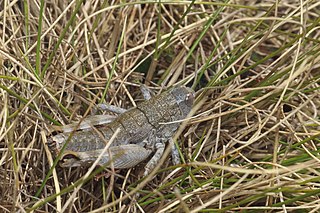
The Green Rock-hopper grasshopper, Brachaspis collinus is an alpine species of short-horned grasshopper in the family Acrididae. It is found in New Zealand in the mountains of northern South Island, above the tree line and as high as 2000 m asl. In New Zealand alpine grasshoppers can freeze solid at any time of the year and are alive when they thaw out when temperatures rise.
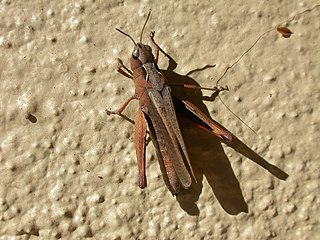
Phaulacridium vittatum, the Wingless Grasshopper, is a species of short-horned grasshopper in the family Acrididae. It is found in Australia.

Hemiandrus celaeno is a species of endemic ground wētā in the family Anostostomatidae. H. celaeno is a small to medium-sized burrowing wētā found along the east coast of the South Island, Aotearoa/New Zealand. Hemiandrus calaeno is a member of the short ovipositor ground wētā. H. celaeno is named for Celaeno of the Pleiades sisters in Greek mythology, whose name means "the dark one". Tag-named entity, H. ‘horomaka’, has been included under H. celaeno.





















